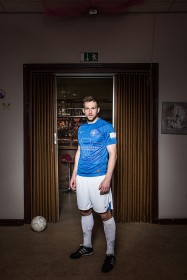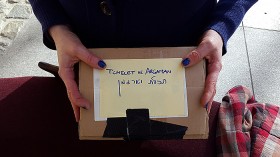The 14th European Maccabi Games (EMG) are beginning tomorrow, 27 July 2015, in Berlin. More than 2,000 Jewish athletes from 36 countries will compete in 19 sports from football to fencing to chess. To accompany the games Tamar Lewinsky and Theresia Ziehe are producing a series of portraits with interviews, introducing a new member of the German delegation from Berlin every day here on the blog. They conducted the interviews on the grounds of the TuS Maccabi in Berlin’s Grunewald where Stephan Pramme also shot the portraits.
Alec-Ilya Pivalov (28), soccer

Alec-Ilya (28), soccer © Jewish Museum Berlin, photo: Stephan Pramme
Alec, why are you taking part in the European Maccabi Games?
It’s a terrific athletic event where you can meet a lot of interesting people from many different countries. By now there’s also a familial atmosphere in the German delegation so it’s just really nice to have the opportunity to participate. And of course it makes you and your family proud.
In 1936, Jewish athletes weren’t permitted to participate in the Olympic Games. Does the fact that some of the competitive events will take place in Berlin’s Olympic grounds – which were built for that Olympics – play a personal role for you?
There is an ambivalence because of course I know the history of this stadium. But in the meantime I associate it with other events: → continue reading

When delivering her art works to the Jewish Museum Berlin, Deborah S. Phillips naturally wears blue nail polish © Jewish Museum Berlin. Photo: Gelia Eisert
A visit to Berlin-Neukölln, to the studio apartment of Deborah S. Phillips, who is dressed in blue, today, except for her shoes, which are green. That the artist has spent the last five years examining the color blue and is only now gradually turning her attention to hues of green is reflected thus in her apparel as well as her art.
Red was the first color to which Deborah Phillips devoted herself with a passion. The Bible story she read aloud as a 12-year-old in the synagogue on the occasion of her Bat Mizwa was about the red cow—and it haunted her for ages. It was the tale of a strange animal that had to be sacrificed so people could use its ashes to cleanse themselves of sin. Only then would they be able to enter the temple in Jerusalem. Many years later, Deborah Phillip’s reflections on the color red and its cultural significance culminated in one of her enchanting works on paper, the “Red Book,” which is the fruit also of the artist’s extensive voyages in Iran, India and Central Asia, and her affinity with Islamic cultures. → continue reading
The last few weeks have been full of hectic hustle and bustle, with boxes being passed from hand to hand, examined, unpacked, and sorted through. Such a variety of objects emerged from their cases and seemed to be disseminating in every direction through the museum.

© Jewish Museum Berlin, photo: Gelia Eisert
Blue prints were spread out over a long, dark red sheet. Words seemed to glow in them – was it “tekhelet” or “argaman” or both? And what do they mean anyway?

© Jewish Museum Berlin, photo: Gelia Eisert
A “magic” card appeared in a kitchenette. Suddenly everything was kosher: the sink, the refrigerator, the dishes, the whole kitchen. The artist promised it would be, and thus it happened. → continue reading



